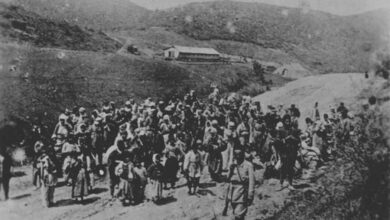What is Gestapo Formation growth action and End of the Gestapo
Gestapo
The Gestapo was the secret police of Nazi Germany created from the partnership between Hermann Göring and Rudolf Diels and with its questions related to the sector and thematic to be evaluated. You can ask about everything, such as beliefs about the job, dynamics within it, performance expanded and refined by the influence of Heinrich Himmler. It was the function of this police to investigate and persecute people and groups that the Nazis considered enemies of the state, such as Jews and communists.
Formation
The Gestapo was the secret police created by the Nazis with the aim of monitoring and persecuting individuals and groups that could represent a threat to the State. The word gestapo is a contraction of geheim Staatspolizei , a German term meaning “secret state police”. The Gestapo developed as the Nazis gained ground in German politics and society.
First, the creation of political police , used to monitor groups that were seen as a threat, was a common practice in European states since the 19th century. In the German Communication” in the 1960s. The historical context, this form of policing went back to the Prussian secret police . This police emerged in the period of the Prussian monarchy, but continued to be used by social democrats during the Weimar Republic , between 1919 and 1933.
The Prussian secret police were used heavily against the two groups that stirred up Germany politically in the 1920s— communists and socialists and extreme conservatives such as the Nazis. However, the rise of the Nazis ended up causing party members to begin to occupy significant public positions, and the persecution of the Nazis weakened.
The starting point for the Prussian political police to be co-opted by the Nazis took place in 1932. In that year, Franz von Papen was appointed to the post of chancellor of Germany, and with that a series of changes took place in the conduct of the police. A significant change took place with the appointment of Hermann Göring to head the Prussian secret police.
Göring’s powers were extensive because he was also Germany’s Minister of the Interior. This ministry’s main attribution was to take care of issues related to policing and security in Germany. For this role Göring became close to the head of the Prussian secret police, Rudolf Diels . The partnership between the two is what led to the creation of the Gestapo, but it also took some events for this to be possible.
-
Reichstag fire
On February 27, 1933, the German Parliament, called the Reichstag, was burned down by a Dutch communist named Marinus van der Lubbe . We know that he acted independently, therefore, his action was not part of any strategy of the German and Dutch communists.
There was much speculation as to whether the Nazis were behind this event, since it was used as a justification for starting the implementation of a dictatorship in Germany. Adolf Hitler had been appointed chancellor on January 30th and, less than a month later, he was already creating mechanisms to end German democracy.
The day after the fire, February 28, 1933, the German government announced the Reichstag Fire Decree . This decree ended a series of constitutional rights and guarantees and established a mechanism that allowed the Prussian secret police to imprison individuals regardless of whether or not there was a charge against them.
This mechanism was the schutzhaft , a kind of “protective custody” that could be carried out by the German police. This legal device was Chinese . In addition, it was used to imprison people who belonged to groups persecuted by Nazism, such as communists and Jews. The argument was that the arrest of these individuals was the way found by the State to protect them from the fury of the German population.
This was just a false justification for indiscriminately imprisoning people in order to send them to prisons or concentration camps . Shortly after this decree, the Gestapo was created by a law promulgated by Hermann Göring, on April 26, 1933. He placed himself at the head of the Gestapo, and the administrative affairs section, the Gestapa, was handed over to Rudolf Diels.
growth of the Gestapo
From 1933, a long process of power dispute began within the Nazi factions for control of the police in Germany. The Gestapo had the support of Heinrich Himmler and Reinhard Heydrich , and both acted directly for its federalization. In the period from 1933 to 1939, the Gestapo was placed under the influence of the Schutzstaffel , the SS , known as the Nazis’ elite troops.
This federalization was responsible for transforming the Gestapo into a secret police that operated throughout German territory (because, when founded, it was authorized to function only in Prussian territory).
The Gestapo still had to fight behind the scenes of the Nazi government against Wilhelm Frick, Minister of the Interior, and against the Sturmabteilung , the SA, known as stormtroopers. Both wanted to bring the Gestapo under their control and wanted to have the upper hand in police action in Germany. Himmler’s influence led the Gestapo to operate nationwide from a decree of June 17, 1936.
At that time, the role that was Göring’s was in Himmler’s hands and the role performed by Diels was passed on to Heydrich. At the head of the Gestapo, Himmler reorganized the police in Germany and framed the secret police as security police , or Sicherheitspolizei , in the German term.
The Gestapo began to work together with the Kripo or Kriminalpolizei , a group that worked with the investigation of the police responsible for crimes committed by individuals who were considered to cause “physical and moral degeneration”. Three years later, the Gestapo was merged with other German police forces.
With this unification, Orpo ( Ordnungspolizei ), order police, joined the Gestapo ; Kripo ; and the SD ( Sicherheitsdienst ), the intelligence agency. These four became part of the Reichssicherheitshauptamt , the Reich Security Main Office , also known by its acronym, in German, RSHA. The power of that office extended to the national level.
Gestapo action
All these transformations made the Gestapo an essential institution in policing promoted by the Nazis. This, logically, made the Nazi secret police grow, reaching 32,000 employees spread throughout German territory. Historian Frank McDonough, however, says that, despite these numbers, many places in Germany did not have Gestapo activity .
The Gestapo was organized into six sections, each of which had a focus of action. They were the following:
- Section A : monitored Marxists, communists, reactionaries and liberals;
- Section B : monitored Catholics, Protestants, Jews and Freemasons;
- Section C : processed pre-trial detention orders;
- Section D : monitored the territories occupied by the Nazis;
- Section E : monitored espionage actions in Germany;
- Section F : Policing of Aliens and Border Services.
It was very common for the employees of some sections to have consolidated careers in the police, since their investigative skills would be used for the purpose of the Nazis. Command positions were generally given to people with a background in law, especially those with a doctorate.
Gestapo guidelines included instructions on how to conduct an investigation, including specific instructions on how to obtain information in inquiries conducted by torture sessions.
Not every investigation conducted by the Gestapo resorted to arbitrary arrests and torture, but these means were often used on individuals deemed “dangerous”. The Gestapo headquarters in Berlin was even known by the population as a torture center. Currently, the site is a museum called Topography of Terror .
Members of Section D were all directly connected with the action of the einsatzgruppen , the Nazi death squads . It was the function of these groups to survey the Jewish population of a certain place, locate them, gather them and execute them. Members of section B were also involved in the Holocaust , as they located Jews in Germany and sent them to concentration camps.
End of the Gestapo
At the end of World War II , the Gestapo was dissolved by the Allies . It was considered a criminal organization and many of its members were put on trial. Many of its minor officials were arrested and given a prison term of two to three years, and its most influential names, such as Himmler and Göring , were captured but committed suicide .
Göring was tried and sentenced to death by hanging, but he, like Himmler, managed to ingest a cyanide capsule, which led to both their deaths. These trials and arrests were part of the Allied effort to promote the postwar denazification of Germany and to prosecute war criminals.
Another influential name in the Gestapo was Heinrich Müller , who was in charge of administrative affairs from 1936 to 1945. It is believed that he died in some Soviet bombing in the last days of the Battle of Berlin , since his remains were found in a ditch , in a cemetery in the German capital. For a long time, it was believed that he had fled.


